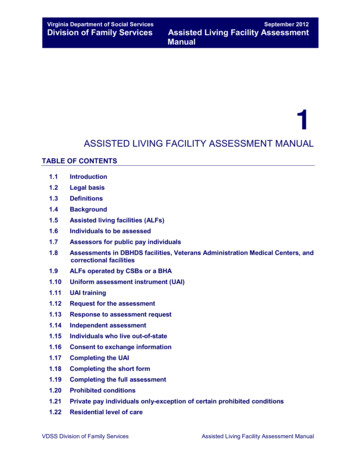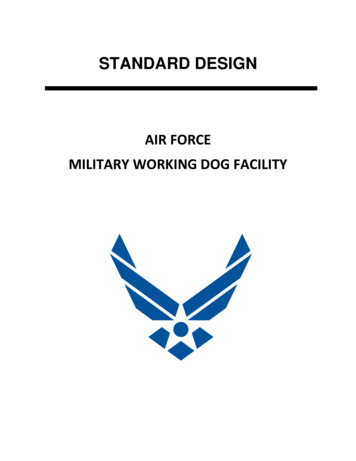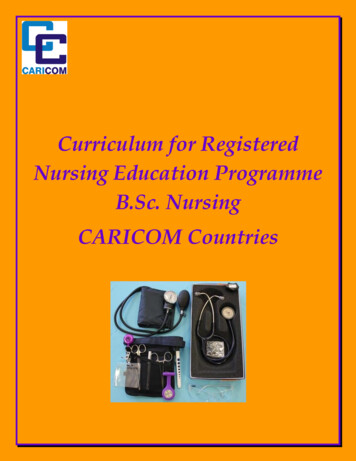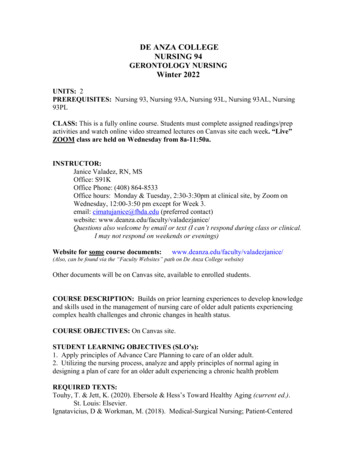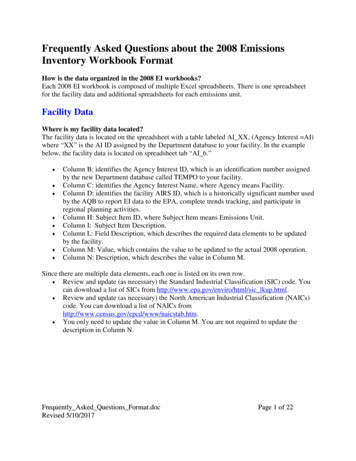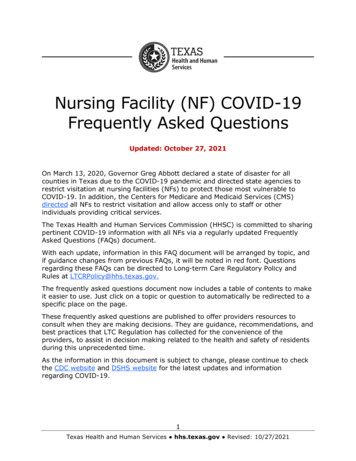
Transcription
Nursing Facility (NF) COVID-19Frequently Asked QuestionsUpdated: October 27, 2021On March 13, 2020, Governor Greg Abbott declared a state of disaster for allcounties in Texas due to the COVID-19 pandemic and directed state agencies torestrict visitation at nursing facilities (NFs) to protect those most vulnerable toCOVID-19. In addition, the Centers for Medicare and Medicaid Services (CMS)directed all NFs to restrict visitation and allow access only to staff or otherindividuals providing critical services.The Texas Health and Human Services Commission (HHSC) is committed to sharingpertinent COVID-19 information with all NFs via a regularly updated FrequentlyAsked Questions (FAQs) document.With each update, information in this FAQ document will be arranged by topic, andif guidance changes from previous FAQs, it will be noted in red font. Questionsregarding these FAQs can be directed to Long-term Care Regulatory Policy andRules at LTCRPolicy@hhs.texas.gov.The frequently asked questions document now includes a table of contents to makeit easier to use. Just click on a topic or question to automatically be redirected to aspecific place on the page.These frequently asked questions are published to offer providers resources toconsult when they are making decisions. They are guidance, recommendations, andbest practices that LTC Regulation has collected for the convenience of theproviders, to assist in decision making related to the health and safety of residentsduring this unprecedented time.As the information in this document is subject to change, please continue to checkthe CDC website and DSHS website for the latest updates and informationregarding COVID-19.1Texas Health and Human Services hhs.texas.gov Revised: 10/27/2021
This is the table of contents. Please click on the question to be directed tothe answer.ContentsReportingI’m required to submit COVID-19 death report data to the National HealthcareSafety Network system. Do I still have to submit COVID-19 and non-COVID-19death reporting data to HHSC?If a facility is having trouble registering or submitting data to the NationalHealthcare Safety Network (NHSN) system, will there be any extensions on thedeadlines to submit our reports? We have heard that some facilities have beencited for failure to submit their data.What can we expect as a facility after we make a report of a staff or resident thathas tested positive for COVID-19? What kind of public resource response can weanticipate? Will HHSC or DSHS or local health department come to the facility toassist?Do NFs need to report to HHSC when there is a case of COVID- 19 in the facility?Cohorting / Resident COVID-19 StatusWhich residents are considered to have “unknown COVID-19 status”?Which residents can be cohorted?If a resident is in a quarantine period and then gets a new roommate, does thefirst resident’s quarantine period start over when the new roommate is admitted?If a resident leaves the facility for a medically necessary appointment and returnsthe same day, is the resident considered to have unknown COVID-19 status, anddo the resident need to be quarantined?Can testing be used to verify COVID-19 status and decrease the number of daysa resident is required to be quarantined and monitored?Is there a statewide prohibition for new admissions if a facility has a positivecase?If a resident is admitted from the hospital and is designated as having “unknownCOVID-19 status,” are they allowed to go to therapy?Can newly admitted residents who are asymptomatic be tested for COVID-19instead of having to be in quarantine for 14 days?What are the risks of the two alternatives for a shortened quarantine?For residents who are newly admitted or readmitted and are quarantined for 14days, are they considered to be suspected of having COVID-19 and treated aspositive, even if they have no signs or symptoms, and do staff have to wear anN95 mask?If a resident receives dialysis or regular eye injections outside the facility, shouldthey be quarantined for 14 days after each visit?If a resident has recovered from COVID-19 and is still within 90 days of illness2Texas Health and Human Services hhs.texas.gov Revised: 10/27/2021
onset, is he or she required to quarantine upon return to the facility?It has taken my facility more than 14 days to receive test results. How do I treatthat resident and those around them?Can NF residents go outdoors on facility property (to the gazebo or within thefenced area of the property, for example) so long as there are 10 people orfewer?Can we have group games for residents if the residents are more than 6 feetapart in NFs?Do NFs need to call ahead to the hospital if the facility is transferring a residentwith respiratory symptoms?Should a NF readmit a resident who has been hospitalized when the resident isreleased from the hospital?Should NF residents be confined to their rooms?If a resident has suspected or confirmed COVID-19, must the door to their roombe kept shut?If a resident is admitted from the hospital after recovering from COVID-19 perthe CDC symptom-based recovery requirements, will the resident still beconsidered to be “unknown COVID-19 status”? Will that resident need to beplaced into a 14-day quarantine?How often do residents need to be screened for signs and symptoms of COVID19?Do fully-vaccinated residents still need to quarantine after exposure to COVID19? Or on admission, readmission, return to a facility?How do we handle outbreak testing for residents?Personal Protective Equipment (PPE)What PPE should be used by staff caring for residents with unknown COVID- 19status?Do fully-vaccinated staff still have to wear PPE?When is an N95 vs. a facemask vs. a face covering required?ResourcesDoes the guidance provided by the Special Infection Control Assessment (SICA)team supersede the COVID-19 Response for Nursing Facilities?Can facilities apply for money to buy communication devices to help residentsstay connected with family and friends. How do I apply?How can I sign up for email alerts from Texas Health and Human Services?Where can I get my COVID-19 Medicaid questions answered?Where do NF providers go for COVID-19 information?Where can I get more information on how to get COVID-19 vaccines?What resources are available to help facilities with staffing shortages?3Texas Health and Human Services hhs.texas.gov Revised: 10/27/2021
Persons Allowed in Nursing FacilitiesShould hospice workers be allowed to enter nursing facilities?When is visitation going to be allowed again?Are dentists considered essential visitors?Are private sitters considered providers of essential services if residents havedementia diagnosis and high risk for falls?Do end-of-life circumstances apply to anyone receiving hospice services?Is it okay for family members to do laundry for residents and leave it at the frontdoor? If so, how do they get the laundry?If there is a fire or an emergency medical situation, do emergency respondersneed to be screened before entering a NF?Are vendors that inspect, test, and maintain fire systems considered essential,and should they be granted entry into a NF?Are personal visitors or essential caregivers required to provide COVID-19 testingresults or to be tested for COVID-19 before entering the facility?Can NF providers require visitors to provide proof of vaccination?When screening staff or any other visitor, does it have to be done outside of thefacility or can it be done inside at the front door or lobby area? What iftemperatures taken outside are reading as higher than usual due to anexcessively hot day?Staff QuestionsIf the lab results come back positive for a staff member, but more than 14 dayshave passed since the test was administered, does the staff member still have toself- quarantine?When should staff use alcohol-based hand rub (ABHR) vs soap and water tosanitize hands?When can a provider employee return to work after being diagnosed with COVID19?What is the best thing to do for facilities that have staff that go to multiplefacilities?Do you know if there is any consideration for pregnant employees?If a NF resident tests positive for COVID-19, how do we handle staff quarantine?How do we handle outbreak testing for staff?Do the alternatives for reduced quarantine apply to nursing facility staff?When should we confirm an antigen test result?Do fully-vaccinated staff have to quarantine if exposed to COVID-19?Do fully-vaccinated staff still have to be routinely tested for COVID-19?Can nursing students enrolled in nursing school do their clinicals in our facilities?4Texas Health and Human Services hhs.texas.gov Revised: 10/27/2021
ReportingI’m required to submit COVID-19 death report data to theNational Healthcare Safety Network system. Do I still have tosubmit COVID-19 and non-COVID-19 death reporting data toHHSC?Yes. NFs are required to submit death reports to HHSC within ten working daysafter the last day of the month via TULIP. NFs must report all deaths that occurwithin the facility and those that occur within 24 hours after transferring a residentto a hospital from the NF. NFs can be cited for failing to submit timely and accuratedeath report information to HHSC.See PL 20-08, PL 20-37, THSC §260A.016, §554.606 and §554.1010 for details.If a facility is having trouble registering or submitting data tothe National Healthcare Safety Network (NHSN) system, willthere be any extensions on the deadlines to submit ourreports? We have heard that some facilities have been cited forfailure to submit their data.Questions about the reporting requirements should be directed toNH COVID Data@cms.hhs.gov.Questions about the NHSN system and enrollment should be directed toNHSN@cdc.govIn addition, the following information can assist providers with challenges they havewith COVID-19 reporting to NHSN:1. The first step is enrolling your facility in National HealthcareSafety Network htmla. Here is slide set for enrolling in vid19-enroll508.pdf2. Next, review the COVID-19 module overview /ltcf/ltcf-covid19-module508.pdf3. Utilize the NHSN forms to gather data to be entered into NHSNa. Resident Impact and Facility f/57.144-res-blankp.pdfb. Staff and Personnel 57.145-staffblank- p.pdfc. Supplies and Personal Protective cf/57.146-suppblank- p.pdf5Texas Health and Human Services hhs.texas.gov Revised: 10/27/2021
d. Ventilator Capacity and f/57.147-vent-blankp.pdfFor additional resources, visit the CDC NHSN LTCF COVID-19 .htmlWhat can we expect as a facility after we make a report of astaff or resident that has tested positive for COVID-19? Whatkind of public resource response can we anticipate? Will HHSCor DSHS or local health department come to the facility toassist?The response will depend on the level of COVID-19 event a facility is experiencingor whether the facility requests assistance. The facility must report every confirmedcase of COVID-19 to their local health department (LHD), or DSHS in jurisdictionswhere there is no LHD.If you suspect your facility is experiencing an outbreak of COVID-19, immediatelynotify your local health department by phone. You can find contact information foryour local/regional health department s/default.shtm?terms local%20health%20entities Work with your local health department to complete the COVID-19case report form if and when necessary.HHSC will serve as the lead state agency in the state’s response to an LTC COVID19 event. HHSC actions may include: Development of testing recommendations, in consultation with DSHSEnsuring appropriate/assistance with resident movementProviding subject matter experts (SME): LTC, HAI, epidemiologyCoordination of HHSC, DSHS, emergency management and local actionsIn addition to the activities above, HHSC coordinates the formation of a TexasCOVID-19 Assistance Team – LTC (TCAT-LTC). This team will includerepresentatives from HHSC, DSHS, local health department (as applicable) andemergency management (as applicable.) This team will assist facilities withmanagement of a COVID-19 event through provision of SMEs, resource requestmanagement, and support to facility actions through initial response activities. TheTCAT-LTC will remain available for a maximum of 48 hours from activation. Stateand local entities will provide SMEs and continued assistance after TCAT- LTCdeactivation.See COVID-19 Response for Long-term Care Facilities for more information.Do NFs need to report to HHSC when there is a case of COVID19 in the facility?Yes. NFs must report the first confirmed case of COVID-19 in staff or residents, aswell as the first confirmed case of COVID-19 after a facility has been without new6Texas Health and Human Services hhs.texas.gov Revised: 10/27/2021
cases for 14 days or more. to HHSC as a self-reported incident within 24 hours ofthe confirmed positive result.The reports should include all information a facility would include in any selfreported incident. The 3613-A should also be completed and submitted within fivedays from the day a confirmed case is reported to CII. The provider investigationreport can be submitted: via TULIPby email at ciiprovider@hhsc.state.tx.usby fax at 877-438-5827 See PL 20-37Cohorting / Resident COVID-19 StatusWhich residents are considered to have “unknown COVID-19status”?UPDATED 7/19/21: Unknown COVID-19 Status: the status of a resident, exceptas provided by the CDC for fully-vaccinated residents or residents who haverecovered from COVID-19, who is a: New admissionReadmissionResident who has spent one or more nights away from the facilityResident who has known exposure or close contact with a person who isCOVID-19 positiveResident who is exhibiting symptoms of COVID-19 while awaiting test resultsWhich residents can be cohorted?Nursing facility residents need to be cohorted with residents who have the sameCOVID-19 status. Facilities should be prepared to have three categories of residentsfor cohorting purposes: Residents without COVID-19 (confirmed negative, recovered, and meet allCDC criteria to discontinue transmission-based precautions, not showingsymptoms)Residents with confirmed cases of COVID-19Residents with unknown COVID-19 status and possible cases of COVID-19 orawaiting test resultsIf a resident is in a quarantine period and then gets a newroommate, does the first resident’s quarantine period startover when the new roommate is admitted?No. Residents who are in the 14-day quarantine and monitoring period do not haveto start the quarantine and monitoring time over if a roommate with unknownCOVID-19 status is brought in at a later date, unless the roommate later testspositive for COVID-19. If either resident later tests positive, the 14- day quarantineand monitoring period starts again the day of the diagnosis.7Texas Health and Human Services hhs.texas.gov Revised: 10/27/2021
While the CDC still endorses a 14-day quarantine period, it now offers twoalternatives and guidance to reduce quarantine timeframes. Local public healthauthorities make the final decisions about how long quarantine should last, basedon local conditions and needs, and providers must follow such decisions. However,in the absence of stricter local quarantine requirements, CDC’s two alternatives are: Alternative #1 - Quarantine can end after day 10 without testing if theperson has no symptoms as determined by daily monitoring.Alternative #2 - Quarantine can end after day 7 if the person tests negativeand has no symptoms as determined by daily monitoring. The test mustoccur on day 5 or later. Quarantine cannot be discontinued earlier than afterday 7.CDC guidance includes the following information: Persons can discontinue quarantine at either alternative described above onlyif the following criteria are also met:o No COVID-19 symptoms were detected in the persons by daily symptommonitoring during the entirety of the quarantine, including up to the timeat which quarantine is discontinued;o Daily symptom monitoring continues through day 14; ando Persons are counseled about the need to adhere strictly through day 14 toall mitigation strategies, such as wearing a mask, avoiding crowds,practicing physical distancing, and practicing hand and cough hygiene.Individuals should be advised that if any symptoms develop, they mustimmediately self-isolate and contact their health care provider to reportthis change in clinical status.o If a nursing facility chooses one of the shortened quarantine options and aresident develops symptoms at any time within 14 days after thequarantine begins, the facility must isolate the resident and report thechange in clinical status to the resident’s attending physician.Testing under alternative #2 above should be considered only if it will haveno impact on community diagnostic testing. Testing of persons seekingevaluation for an actual infection must be prioritized.Persons can continue to be quarantined for 14 days without testing, per existingrecommendations. This option is maximally effective.If a resident leaves the facility for a medically necessaryappointment and returns the same day, is the residentconsidered to have unknown COVID-19 status, and do theresident need to be quarantined?No. Residents who leave the facility for medically necessary appointments andreturn the same day are not considered to have unknown COVID-19 status. Rather,their COVID-19 status is the same as it was when the resident left the facility fortheir appointment, and they can return to their assigned room. These residentsshould wear face coverings, as tolerated, while out of the facility.8Texas Health and Human Services hhs.texas.gov Revised: 10/27/2021
Can testing be used to verify COVID-19 status and decrease thenumber of days a resident is required to be quarantined andmonitored?All residents who have unknown COVID-19 status must be quarantined andmonitored in accordance with CDC guidance.While the CDC still endorses a 14-day quarantine period, it now offers twoalternatives and guidance to reduce quarantine timeframes. Local public healthauthorities make the final decisions about how long quarantine should last, basedon local conditions and needs, and providers must follow such decisions. However,in the absence of stricter local quarantine requirements, CDC’s two alternatives are: Alternative #1 - Quarantine can end after day 10 without testing if theperson has no symptoms as determined by daily monitoring.Alternative #2 - Quarantine can end after day 7 if the person tests negativeand has no symptoms as determined by daily monitoring. The test mustoccur on day 5 or later. Quarantine cannot be discontinued earlier than afterday 7.CDC guidance includes the following information: Persons can discontinue quarantine at either alternative described above onlyif the following criteria are also met:o No COVID-19 symptoms were detected in the persons by daily symptommonitoring during the entirety of the quarantine, including up to the timeat which quarantine is discontinued;o Daily symptom monitoring continues through day 14; ando Persons are counseled about the need to adhere strictly through day 14 toall mitigation strategies, such as wearing a mask, avoiding crowds,practicing physical distancing, and practicing hand and cough hygiene.Individuals should be advised that if any symptoms develop, they mustimmediately self-isolate and contact their health care provider to reportthis change in clinical status.o If a nursing facility chooses one of the shortened quarantine options andthe resident develops symptoms at any time within 14 days after thequarantine begins, the facility must isolate the resident and report thechange in clinical status to the resident’s attending physician.Testing under alternative #2 above should be considered only if it will haveno impact on community diagnostic testing. Testing of persons seekingevaluation for an actual infection must be prioritized.Persons can continue to be quarantined for 14 days without testing, per existingrecommendations. This option is maximally effective.UPDATED 3/23/21: Quarantine and fully-vaccinated residentsThe following recommendations are based on what is known about currentlyavailable COVID-19 vaccines. Please continue to check the CDC’s Infection Controlafter Vaccination for the latest updates to these recommendations.9Texas Health and Human Services hhs.texas.gov Revised: 10/27/2021
Fully-vaccinated refers to a person who is: At least two weeks following receipt of the second dose in a two-dose COVID19 vaccine series, or at least two weeks following receipt of one dose of asingle-dose COVID-19 vaccine.Prolonged close contact refers to contact within 6 feet for a cumulative total of15 minutes or more over a 24-hour period.For asymptomatic residents: Quarantine is no longer recommended for residents who are being admitted to apost-acute care facility, such as a nursing facility, if they are fully-vaccinatedand have not had prolonged close contact with someone with a COVID-19infection in the prior 14 days. This includes new admissions, readmissions, and aresident who was gone overnight – as long as the resident did not haveprolonged close contact with someone with a COVID-19 infection. UPDATED 10/27/2021: Asymptomatic residents who have had prolongedclose contact with someone with COVID-19 infection, regardless of vaccinationstatus, should have a series of two viral tests for COVID-19 infection(immediately after exposure, but not earlier than 2 days after exposure AND 5-7days after exposure) unless they have recovered from COVID-19 within the last90 days. If they have recovered from COVID-19 in the last 90 days and remainasymptomatic, they do not need to be tested even if they had close contact. UPDATED 10/27/2021: Quarantine is no longer recommended for fullyvaccinated residents following prolonged close contact with someone with aCOVID-19 infection. Fully vaccinated, asymptomatic residents and asymptomaticresidents who have recovered from COVID-19 infection in the last 90 days donot need to be quarantined, restricted to their room, or cared for by HCP usingthe full PPE recommended for the care of a resident with COVID-19 infection,unless they develop symptoms of COVID-19, are diagnosed with COVID-19infection, or the facility is directed to do so by the local public health authority.oThere may be circumstances when quarantine for these residents mightbe recommended, e.g., when the resident is moderately to severelyimmunocompromised, if the initial diagnosis of COVID-19 infection mighthave been based on a false positive test result. In the event of ongoingtransmission within a facility that is not controlled with initialinterventions, strong consideration should be given to quarantine for fullyvaccinated residents on affected units and work restriction of fullyvaccinated HCP with higher-risk exposures. In addition, there might beother circumstances for which the jurisdiction’s public health authorityrecommends these and additional precautions. See the CDC’s InterimInfection Prevention and Control Recommendations for HealthcarePersonnel During the Coronavirus Disease 2019 (COVID-19) Pandemic formore information.Fully-vaccinated people who do not quarantine should still watch for symptoms ofCOVID-19 for 14 days following an exposure. If they experience symptoms, they10Texas Health and Human Services hhs.texas.gov Revised: 10/27/2021
should be clinically evaluated for COVID-19, including testing for COVID-19, ifindicated.Unvaccinated residents who have had close contact with someone with COVID-19infection should be placed in quarantine for 14 days after their exposure, even ifviral testing is negative. HCP caring for them should use full PPE (gowns, gloves,eye protection, and N95 or higher-level respirator).Although not preferred for healthcare settings, options for shortening quarantineare available.Is there a statewide prohibition for new admissions if a facilityhas a positive case?No. While local orders related to NF admissions might apply in parts of the state,there is not a statewide or federally mandated prohibition on new admissions forfacilities that have COVID-19 cases. Facilities should continue to admit anyone theywould normally admit but with all appropriate precautions.If a resident is admitted from the hospital and is designated ashaving “unknown COVID-19 status,” are they allowed to go totherapy?Yes. The resident can go to therapy. The NF should have a plan to ensure theresident does not have contact with COVID-19 positive or COVID-19 negativeresidents; the resident should wear a facemask or face covering as tolerated, inaccordance with CDC guidance, while out of the bedroom; and infection controlmeasures should be followed to disinfect the therapy room and all equipmentbefore and after each use.Can newly admitted residents who are asymptomatic be testedfor COVID-19 instead of having to be in quarantine for 14 days?In general, unvaccinated new admissions, readmissions, and other residents withunknown COVID-19 status must remain in quarantine and be monitored for signsand symptoms of COVID-19 in accordance with CDC guidance.While the CDC still endorses a 14-day quarantine period, it now offers twoalternatives and guidance to reduce quarantine timeframes. Local public healthauthorities make the final decisions about how long quarantine should last, basedon local conditions and needs, and providers should follow such decisions. However,in the absence of stricter local quarantine requirements, CDC’s two alternatives are: Alternative #1 - Quarantine can end after day 10 without testing if theperson has no symptoms as determined by daily monitoring.Alternative #2 - Quarantine can end after day 7 if the person tests negativeand has no symptoms as determined by daily monitoring. The test mustoccur on day 5 or later. Quarantine cannot be discontinued earlier than afterday 7.CDC guidance includes the following information:11Texas Health and Human Services hhs.texas.gov Revised: 10/27/2021
Persons can discontinue quarantine at either alternative described above onlyif the following criteria are also met:o No COVID-19 symptoms were detected in the persons by daily symptommonitoring during the entirety of the quarantine, including up to the timeat which quarantine is discontinued;o Daily symptom monitoring continues through day 14; ando Persons are counseled about the need to adhere strictly through day 14 toall mitigation strategies, such as wearing a mask, avoiding crowds,practicing physical distancing, and practicing hand and cough hygiene.Individuals should be advised that if any symptoms develop, they mustimmediately self-isolate and contact their health care provider to reportthis change in clinical status.o If a nursing facility chooses one of the shortened quarantine options andthe resident develops symptoms at any time within 14 days after thequarantine begins, the facility must isolate the resident and report thechange in clinical status to the resident’s attending physician.Testing under alternative #2 above should be considered only if it will haveno impact on community diagnostic testing. Testing of persons seekingevaluation for an actual infection must be prioritized. Persons can continue to be quarantined for 14 days without testing, per existingrecommendations. This option is maximally effective.UPDATED 3/23/21: Quarantine and Fully-vaccinated ResidentsThe following recommendations are based on what is known about currentlyavailable COVID-19 vaccines. Please continue to check the CDC’s Infection Controlafter Vaccination for the latest updates to these recommendations.Fully-vaccinated refers to a person who is: At least two weeks following receipt of the second dose in a two-dose COVID19 vaccine series, or at least two weeks following receipt of one dose of asingle-dose COVID-19 vaccine.Prolonged close contact refers to contact within 6 feet for a cumulative total of15 minutes or more over a 24-hour period.For asymptomatic residents: Quarantine is no longer recommended for residents who are being admitted to apost-acute care facility, such as a nursing facility, if they are fully-vaccinatedand have not had prolonged close contact with someone with a COVID-19infection in the prior 14 days. This includes new admissions, readmissions, and aresident who was gone overnight – as long as the resident did not haveprolonged close contact with someone with a COVID-19 infection. UPDATED 10/27/2021: Asymptomatic residents who have had prolongedclose contact with someone with COVID-19 infection, regardless of vaccinationstatus, should have a series of two viral tests for COVID-19 infection(immediately after exposure, but not earlier than 2 days after exposure, AND 512Texas Health and Human Services hhs.texas.gov Revised: 10/27/2021
7 days after exposure), unless they have recovered from COVID-19 within thelast 90 days. If they have recovered from COVID-19 in the last 90 days andremain asymptomatic, they do not need to be tested even if they had closecontact. UPDATED 10/27/2021: Quarantine is no longer recommended for fullyvaccinated residents following prolonged close contact with someone with aCOVID-19 infection. Fully vaccinated, asymptomatic residents and asymptomaticresidents who have recovered from COVID-19 infection in the last 90 days donot need to be quarantined, restricted to their room, or cared for by HCP usingthe full PPE recommended for the care of a resident with COVID-19 infection,unless they develop symptoms of COVI
Nursing Facility (NF) COVID -19 Frequently Asked Questions . Updated: October 27, 2021 . . For residents who are newly admitted or readmitted and are quarantined for 14 days, are they considered to be suspected of having COVID-19 and treated as positive, even if they have no signs or symptoms, and do staff have to wear an .





